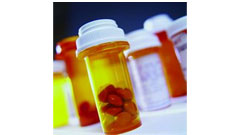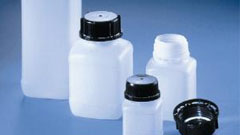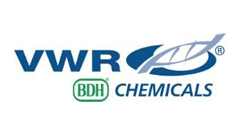Chemicals for sample preparation
Sample preparation is as important as the analysis of your sample. Make sure you use the right reagents to avoid contamination of your sample.
Please refer to below Tips & Techniques Section to learn more
Product Categories

ACS and Reag. Ph. Eur Solvents
Complete range of solvents suitable for a multitude of analytical and R&D applications with garanteed specifications conform to ACS and Reag PH EUR for most of them, available in different pack size.

ACS and Reag. Ph. Eur Acids and alkalis
For sample preparation, PH adjusters or other applications, acids and alkalis are often used. You will find a complete range of these products in different packs.

ACS and Reag. Ph. Eur salts
Complete range of salts in analytical grade conform to ACS, Reag PH EUR for the big majority.

Reag. Ph. Eur. Standard solutions
For quality control in pharmaceutical companies, over 250 standards and solutions conform to the last PH EUR version delivered with a complete CoA insuring a complete traceability.

Acids and Solvents in plastic bottles
Solvents and acids in plastic bottles are safe, virtually unbreakable, environmentally, friendly, light and easy to handle.

Acids and Solvents in coated glass bottles
This kind of "safe" packaging is really helpful for corrosive reagents. The PE-coating contains the product when the glass bottle is broken.
Tips & Techniques
All inorganic salts are produced from inorganic raw materials. Since no animal-derived material is used for in the production of these compounds it can be assumed that they are BSE-free.
Decahydrates and dodecahydrates such as sodium carbonate decahydrate, sodium sulphate or di sodium hydrogen phosphate dodecahydrate lose some their crystallisation in water at 33 °C. It can be said that they melt in their own crystallisation water. It is, therefore, important to store and transport these compounds under cool conditions (below 20 °C) mainly during the summer months.
Some salts such iron (II) sulphate heptahydrate, ammonium iron (II) sulphate hexahydrate or tin (II) chloride dihydrate are potent reducing agents, which at higher temperatures or when exposed to direct sunlight, readily change into a higher oxidation state. These products must, therefore, be stored under cool, dark conditions (15 °C). Nevertheless, the minimum shelf life of these products is limited to 1 year, even under ideal storage conditions.
Some compounds are explosive and may not be sold as dry substances but only mixed with water. For instance, ammonium dichromate (stab. with 0,5 to 3% water), ammonium nitrate (min. 3% water ) or 2,4 dinitrophenol (0,5 ml H2O2/g).
There are many different pack sizes available such as 100, 250, 500, 2500 or 5000 g. For some products 25 kg is also available. Check out our website or chemical catalogues.
di-Sodium hydrogen phosphate (Na2HPO4) is designated a dibasic phosphate, and sodium dihydrogen phosphate (NH2PO4) a mono basic phosphate.
Besides frequently used organic lubricants, there are also inorganic lubricants. The lubricating effect is based on the layered structure of these compounds. Common lubricants consist of boron nitride, molybdenum (IV) sulphide or graphite fine powder. These compounds can be used both at low and higher temperatures.
Vitriols are sulphates or divalent metals in their hydrated, crystalline form such as copper (CuSO4. 5H2O), iron (FeSO4.7H2O) or zinc (ZnSO4.7H2O).
Ammonium carbonate is the salt of carbonic acid, and ammonium carbamate is the salt of carbamic acid. Ammonium carbamate is much more stable than ammonium carbonate, and changes into the latter only in aqueous solution as is the case when boiling it.
Iodine is only slightly soluble in water, whereas it readily dissolves in a concentrated potassium iodide solution by forming complexes. The solution should, however, be diluted further only after all of the iodine dissolves, and this very slow despite the presence of potassium iodide.
Caustic alkalis is a term used to call the hydroxides of alkali metals. They occur in solid form and are generally manufactured as pellets. Alkali solutions are the aqueous versions of these hydroxides. The most commonly used caustic alkalis and alkali solutions are those of sodium and potassium.
Alkali solutions can be directly titrated with standard acids.
If possible, and only if really necessary, mix nothing other than dilute alkali solutions with dilute acids whilst stirring vigorously. Wear protective gloves, glasses and overalls, and work under a hood. Very cautiously stir the alkali solution into the acid. Pay careful attention to all rules for safe working.
Slowly and vigorously stir the required quantity of sodium hydroxide or potassium hydroxide pellets into water at +20 °C. Be aware that a great deal of heat may be produced.
When necessary, these solutions can be diluted by cautiously stirring into water, followed by neutralisation with hydrochloric acid. Be sure to wear protective gloves and glasses and to work under a hood. Before emptying into a collection container, make sure you take a pH reading using pH universal indicators strips.
The pellets are soluble in alcohol and insoluble in acetone and di ethyl ether.
Carbonates are only slightly soluble in sodium and potassium hydroxide solutions. The more concentrated the solution is, the lower the carbonate content, as carbonates preciptate out.
 Chemical Innovations
Chemical Innovations